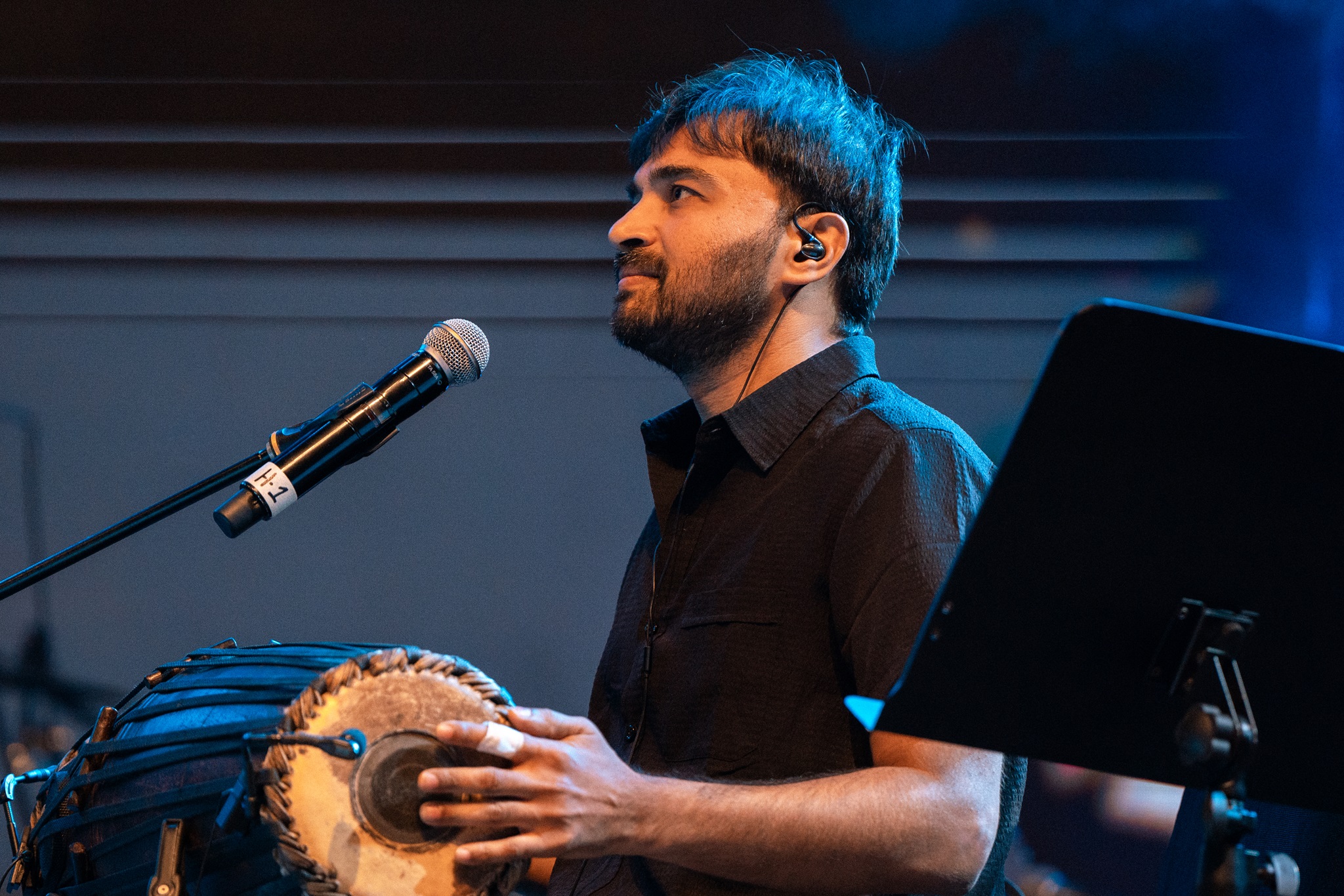The artist, who recently released an album with fellow genre-fluid percussionists Viveick Rajagopalan and B.C. Manjunath, also performed at Mahindra Percussion Festival in Bengaluru as part of Rajagopalan’s experimental duo Two Summ

Artist Anantha R. Krishnan at Mahindra Percussion Festival in Bengaluru last month. Photo: Courtesy of Mahindra Percussion Festival.
In August last year, artist Anantha R. Krishnan performed with chenda veteran Panamanna Sasi and his troupe in a thayambaka [performance] in the town of Chuduvalathur in Palakkad district, Kerala. It was dubbed as a jugalbandi, one that took place inside a temple.
Looking back at the experience, Krishnan – a mridangam artist and percussionist – terms the musical drive of Sasi and his troupe as “devotional rhythm,” which he feels is acutely different from rhythms for “academic or entertainment” purposes where there’s an expected audience. “They perhaps feel God is their audience and in that capacity, that’s a very awe-inspiring environment to be in,” Krishnan says.
Krishnan – the grandson and disciple of mridangam legend Palghat R. Raghu – it’s not just about the mridangam or being called to play that particular instrument associated with Carnatic music. He says he would like to bring his artistry and not just the instrument to the front when he’s called on as a performer.
In the months since then, Krishnan has gone on to be a part of MAV and the Mridangams – with fellow percussion aces Viveick Rajagopalan and B.C. Manjunath – and performed as part of experimental duo Two Summ with Rajagopalan, at the Mahindra Percussion Festival in Bengaluru last month. Raised in the U.S., the artist would often visit India to be trained by Palghat R. Raghu, since the age of five.
When asked to compare the popularity of mridangam as a primary instrument rather than just an accompanying element in Carnatic concerts and compositions, Krishnan says the era that his grandfather thrived in was a time when Indian music was often exported around the world as part of cultural delegations, sponsored by governments. He points out that Indian music – with the mridangam included – had become a “great global talking point” to the extent that jazz great Dave Brubeck even created a track called “Raga Theme for Raghu” with Palghat Raghu on 1971’s Summit Sessions album.
In terms of the changes in popularity over the decades since, Krishnan says things go in and out of fashion in a cyclical way. “Perhaps now again, there is interest coming back to the mridangam and konnakol,” he adds. There are often conversations between his peers and senior musicians about what it takes to stay relevant in the professional realm. “In all of these conversations, the love for the mridangam and the depth of sound it offers is what we all gravitate to in the end, sometimes teary-eyed. The mridangam is a very healing sound at its core being,” Krishnan adds.
His way of showcasing the potential and relevance of the mridangam, then, is a “very personal exercise” that draws from his life and journey, including experiences like performing with Panamanna Sasi in Kerala. While fusion and collaborations are often seen as the definitive way to keep traditional music instruments and elements in the spotlight, Krishnan says it’s also up to mainstream media to change perceptions. “It would be nice if […] mainstream media can cover traditional spaces and make them more approachable for larger audiences to see these acoustic instruments in their homes,” Krishnan adds.
The space, too, matters. Krishnan brings it back to his recent Kerala performance and says if it had taken place in a black box theater or a concert hall, “it would have been a different and wonderful moment also, but, the true nature of the experience, I think would be misplaced.”
There’s a time and manner to bring the mridangam to those settings as well, as Krishnan proved when he performed a traditional set in January 2020, alongside Viveick Rajagopalan’s hip-hop/fusion act Ta Dhom Project at Royal Opera House in Mumbai. With Rajagopalan, art director Kunal Naik and production head K.G. Ramnarayan, Krishnan is also part of MridangaMela, a project that – as the name suggests – celebrates the mridangam. It developed out of a “wonderful, deep friendship” with Rajagopalan and became a festival entity, but also featured interviews and podcasts during the peak pandemic lockdowns, featuring Indian greats like Trilok Gurtu and Shubha Mudgal.
As much preserving and passing down the rich history and might of the mridangam is key, so is taking risks to contemporize the instrument, even in the face of gatekeepers and purists. Krishnan is clear, however, “The audiences will never tolerate something which is done or performed without conviction. A half-baked sound will sink, hard.” As for purists, he has a simpler answer. “I find them endearing because most of them are much older, and they want to tell you what they loved when they were young. if you give them a warm hug, they are quite happy in the end,” he says.
Kobalt will provide Madverse’s community of songwriters, composers, and producers with comprehensive global publishing services…
From ‘Moving’ to ‘Cashero,’ K-drama superheroes’ powers come with strings attached — and it’s this…
The highly-anticipated LP will take its name from a traditional Korean folk song that is…
From a ‘Rockstar’ fanmeet, to an immersive food festival, to a murder mystery party, these…
The New Delhi hip-hop duo’s 10th anniversary celebrations rolls into 2026 with shows in Australia,…
Yasuhiro Nightow’s Space Western Trigun gets new life in its brand-new reimaging, 'Trigun Stargaze'